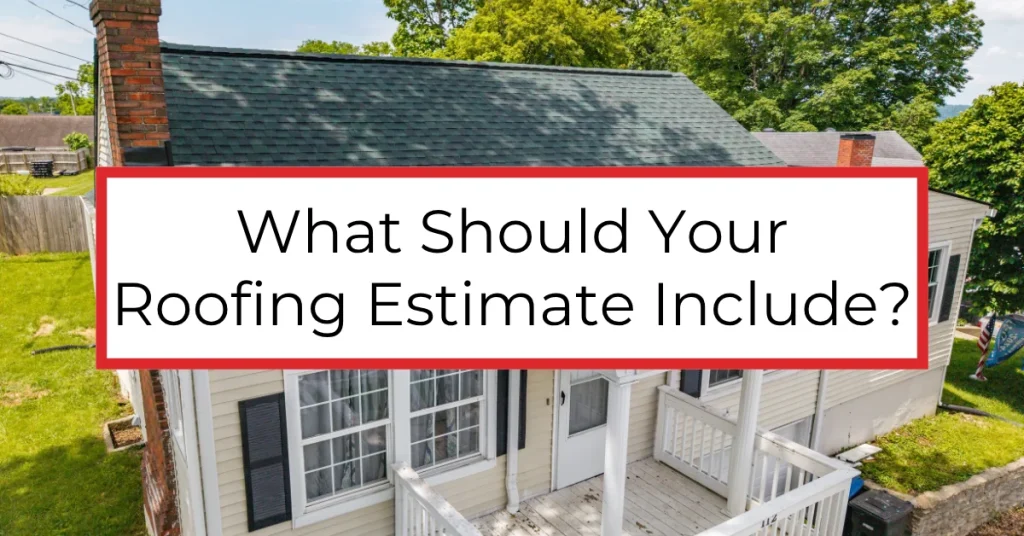Your roof has many more components than just the shingles you’re able to see. All of these components form a roofing system that works together to protect your home. When it comes time for replacement, every component of your roofing system most likely needs to be replaced.
In order to win your business, some roofing contractors will intentionally leave out items or quote you the lowest possible quality to undercut the competition. Customers find out in the middle of their replacement or even worse – shortly after their replacement, that a critical piece of their roofing system was neglected.
To make sure this doesn’t happen to your central Kentucky home, we’ve listed the items of your roofing system that need to be included on your roofing estimate. We always recommend getting a few roofing estimates to make sure you’re getting a fair price. For all your roofing estimates – especially if one comes in much lower than the others, make sure they each include the following items:
1. Decking
Under the shingles of your roof there are sheets of plywood or sheathing. Think of this as the foundation of your roof.
Your roof decking will not need to be replaced for every roof replacement. A contractor would recommend redecking if your home was built in the 1960’s -1980’s (or earlier) and is undergoing its third or fourth roof replacement. The plywood or sheathing becomes so worn and full of holes from previous replacements, it cannot hold new nails and shingles.
Additionally, redecking may be also necessary if your roof decking has a significant amount of dry rot. Dry rot is caused by improperly ventilated attics that cause the plywood or sheathing to warp.
2. Underlayment
Underlayment must be included in your roof replacement estimate. Underlayment is the last line of defense to protect your roof decking from water damage. There are varying levels of underlayment quality – we recommend synthetic underlayment to our customers.
3. Ice & Water Shield
An ice and water shield forms a moisture tight seal on top of your underlayment. Meaning, when shingles are nailed in, the ice and water shield forms a water tight seal around the nail. In most places, namely central Kentucky, local regulations require an ice and water shield in certain areas of your roof.
4. Drip Edge
Your drip edge has to be replaced with your roof. Aside from being required by local code and regulations, this is another critical component in leak prevention. The drip edge is a metal flashing that is positioned at the roof’s perimeter to direct water away from your fascia boards. If you choose to not install drip edges during your roof replacement, it could seriously hinder your ability to sell your home. Without drip edges, your home would fail an inspection report held before closing.
5. Ventilation
As we discussed with your roof decking, proper ventilation is critical to the longevity of your roof and preventing costly dry rot damage. New roof vents should be included in your roof replacement. Of course, there are varying levels of quality in regards to ventilation. It’s important to understand the difference between passive and active ventilation, and ask your contractor what makes the most sense for your home.
6. Pipe Boots/ Roof Boots
Penetrations in your roof due to HVAC and plumbing must be sealed. A pipe boot is fitted around these penetrations to form a watertight seal. Cracked pipe boots are one of the most common causes of a roof leak. It’s important to replace your pipe boots with your roof to ensure it’s fitted correctly. As part of your yearly roof maintenance, you should have your pipe boots inspected to ensure it is not cracked.
7. Shingles/Material Quality
Roofing contractors will quote different shingle qualities. Contrary to popular belief, shingle quality really comes down to aesthetic preferences. Higher grade shingles typically have the same material warranty as mid-grade shingles. This is important to note as you’re comparing roofing estimates.
8. Flashings
Flashings are a critical component of your roof to prevent leaks and direct water away from certain parts of your roof. You may not have to replace your flashing during a roof replacement. However, if their integrity has been damaged or if you’re switching from a 3-tab to a dimensional asphalt shingle then it’s highly recommended to do so.
While some contractors might tell you that you don’t have to replace your flashings during a roof replacement, we strongly advise doing so. It boils down to preventing problems and leaks in the future. Plus, flashing is something you’ll ultimately have to replace, and it’s cheaper and easier to do it during a replacement.
Wrapping Up
Our mission is to help educate homeowners so they can make informed, confident decisions about their home. From what questions to ask a roofing contractor, to evaluating and comparing your roofing estimates, you can find help for every step of the process on our Learning Center.
Roofing estimates from different contractors will include different qualities of materials, levels of customer service and warranties. We recommend getting a few roofing estimates before selecting the contractor that’s best for your home.
Default insurance Lexington Louisville Richmond roof replacement
